Order: Charadriiformes
Family: Laridae
Genus: Larus
Species: Larus delawarensis
![By Dick Daniels (http://carolinabirds.org/) (Own work) [CC-BY-SA-3.0 or GFDL], via Wikimedia Commons](http://blogs.evergreen.edu/birds/files/2012/10/320px-Ring-billed_Gull_Larus_delawarensis_RWD1-300x225.jpg)
By Dick Daniels (http://carolinabirds.org/) (Own work) [CC-BY-SA-3.0 or GFDL], via Wikimedia Commons
Introduction
The Ring-billed Gull is a charismatic bird with a very distinctive call and bold markings.Ring-billed Gulls are most identifiable from other members of the Laridae family by the black ring around their bills and the small white dots on their black wing tips (Pollet et al. 2012). Other characteristics of this medium sized gull include a white body, white tail, and white head with brown striping (Pollet et al. 2012). In the breeding season, these Gulls lose the brown on their heads (Pollet et al. 2012). In addition to the black and white wing tips, this gull has grey wing and back feathers (Pollet et al. 2012). Besides the black ring, the rest of its bill is yellow just like its legs (Pollet et al. 2012). Juvenile Ring-Billed Gulls have brown and white streaked feathers, black tipped pink bills, and pink legs (Crowe 2007). After each molt they get more and more of their adult plumage (Crowe 2007). It takes around three years for them to achieve full adult coloring (Crowe 2007). Male and female Ring-billed Gulls look nearly identical (Ryder 1978). A study by John Ryder revealed the bills of male Ring-billed Gulls were generally larger compared to females, although some overlap did occur (Ryder 1978). These gulls generally live 10 to 20 years in the wild but have been documented living over 30 years (Southern 1975).

InfoNatura: Animals and Ecosystems of Latin America [web application]. 2007. Version 5.0 . Arlington, Virginia (USA): NatureServe. Available: http://www.natureserve.org/infonatura. (Accessed: December 5, 2012 ).
Around Evergreen, the Ring-billed Gull can be found near many of our local beaches. One good place to look is the trail off Marine Drive, another is the beach by F-Lot, and you can also find them down the road at The Nisqually Wildlife Refuge. Some, on occasion, can even be seen on the main campus.
The Ring-billed gull is a vivacious scavenger that takes advantage of a variety of foraging locations and techniques in order to find a meal (Belant et al. 1998). They have a highly variable diet consisting mostly of high protein foods such as small crabs, rodents, grains, and fish (Belant et al. 1998). When nesting at landfills their diet also includes discarded morsels of chicken and beef (Belant et al. 1998). Ring-billed Gulls have also been documented eating the berries from Cabbage Palmettos (a type of palm tree) (Cruickshank 1950). Recently people have been noticing a pink coloration in the feathers of some Ring-billed Gulls (McGraw and Hardy 2006). It is assumed birds with this coloration have more salmon in their diets and pick up higher concentrations of carotenoid pigments (responsible for yellow, orange, and red) (McGraw and Hardy 2006).
Ring-billed Gulls are also known to rob from nests (Brown and Lang 1996). In a study of color-banded Ring-billed Gulls around Lake Erie, some were observed consuming whole eggs and live chicks of their same species (Brown and Lang 1996). In another example from Indiana, sample nests of the Least Tern (Sternula antillarum) were made to investigate their predators (Devault et al. 2005). Results found that most of the predation was due to Ring-billed Gulls (Devault et al. 2005). Despite their widely variable diets some limitations occur when it comes to how much salt they can ingest as juveniles (McLellan and Shutler 2009). The results of a study on what nestlings of Ring-billed Gulls were being fed showed a majority of the food was from a fresh water environment versus a salt water one (McLellan and Shutler 2009). It is speculated this is because the Ring-billed Gull cannot process as much salt as other species of gull (McLellan and Shutler 2009).
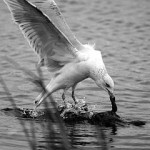
By Tim Lenz (originally posted to Flickr as Gull vs. Turtle) [CC-BY-2.0], via Wikimedia Commons
Ring-billed Gulls generally stay in flocks, forage in groups, and nest colonially (Racine et al. 2012). Even though these birds can be very social, a recent study suggests colonies of Ring-billed Gulls that share close nesting sites may not verbally exchange information regarding food and foraging locations while on the nest (Racine et al. 2012). This was determined by tracking which birds interacted with each other and where those birds later flew to forage (Racine et al. 2012). In another study they determined the birds were taking visual cues from each other when flying (Hoffman et al. 1981). If a Gull saw another bird diving or demonstrating foraging behavior it would redirect its course and join the other bird (Hoffman et al. 1981).
Ring-billed Gulls are known to actively practice kleptoparasitism, where they bother and chase other birds in order to obtain their food (Burger and Gochfeld 1981). The adult birds tend to use this practice more often than juveniles and are usually more successful in stealing food (Burger and Gochfeld 1981). In Manitoba, one Ring-billed Gull attacked a whole group of diving ducks until they abandoned some food for the gull to later retrieve (Walley 2006). In another case a gull attacked a Bufflehead after it dived under and retrieved a food item and the gull chased after it until it decided to drop the food for the gull to eat (Walley 2006).
A study from 1978 explains certain activities exhibited by the Ring-billed Gull can be described as play behavior (Brackbill 1978). While flying, the bird will drop an item, let it fall a short way and then quickly fly down to catch it in mid-air (Brackbill 1978). They will also plunge into the water from a short distance above the surface and because they are very buoyant they immediately bob back up, sometimes with a non-food substrate (i.e. a dead leaf or grass) in their bill, this behavior is also sometimes used to catch food (Brackbill 1978). If one bird starts performing one of these actions more will often join in (Brackbill 1978). Because they will perform these activities without actually retrieving any food, Brackbill thinks it is likely they are playing to pass the time and practice catching prey (Brackbill 1978).
Ring-billed Gulls are considered monogamous and will remain in pairs for approximately two years (Pollet et al. 2012). In a male-female pairing a clutch size is generally two to five eggs (Pollet et al. 2012). Sometimes there are also pairings of two females together who will have one “supernormal clutch” of five to eight eggs (Ryder and Somppi 1979). One study determined the eggs from female-female pairs have lower hatch success (Ryder and Somppi 1979). This is probably because it is not always possible for the females to find males willing to mate without forming a pair bond or males that will mate when they already have a partner (Lagrenade and Mousseau 1983). Another study tested the hypothesis that female-female pairings happen because there are not enough males in a population (Conover and Hunt 1984). They researched population sizes and male to female ratios from historical data in four gull species (Conover and Hunt 1984). Conover found that in the case of the Ring-billed gull there was a much higher number of females where female-female pairings occur, but the data for the three other species show a relatively even number of males to females making the overall data not statistically significant (Conover and Hunt 1984).
Many birds will lay eggs that easily blend in with the nesting site to lessen the likelihood of predators eating their eggs (Hanley and Doucet 2009). However, the Ring-billed Gull lays eggs of a blue-green coloration (Hanley and Doucet 2009). Some ecologists suggested this coloring may be a signal for males that the female is a high value mate (Hanley and Doucet 2009). Some studies have been conducted to tie quality of a mate to the egg coloration but nothing has been received as compelling evidence (Hanley and Doucet 2009). It is still a great start to determining how Ring-billed gulls chose a mate (Hanley and Doucet 2009).
In the early 1900’s there was a drastic decline in Ring-billed Gull populations of northeast America because of hunting for their feathers (Greenlaw and Sheehan 2003). In the mid 1900’s populations grew exponentially and by the 1960s the numbers began to stabilize (Greenlaw and Sheehan 2003). Population data shows there has not been a statistically significant increase from 1966 to 2012 (Sauer et al. 2014). Currently, there are certain areas that are considered overpopulated and many different things have been tried in order to decrease the Gull population (Engeman et al. 2012). During the breeding season and after chicks fledge at Lake Michigan the population becomes large enough that water quality becomes too contaminated for people to swim (Engeman et al. 2012). Over the course of three summers, egg-oiling was implemented (coating eggs in corn oil) so the birds would reject their eggs (Engeman et al. 2012). The problem with this strategy is that if the program is not continued each year the birds end up returning (Engeman et al. 2012). Also, because the Ring-billed Gull poses a threat to aquaculture, the U.S. Fish and Wildlife Services permit some people to kill a predetermined number of the gulls (Blackwell et al. 2000). Their efforts have not shown to decrease the overall population of these birds (Blackwell et al. 2000). Kill and trap tactics are not effective for long term control of the population unless kept up on an annual schedule (Conover 2002). A more helpful practice is removing a resource the birds are there for (Conover 2002). In the case of Lake Michigan, better waste disposal techniques could be implemented such as, more trash cans and clean-up crews (Engeman et al. 2012). A lack of human provided food would make the area less desirable to Gulls (Conover 2002).
This was recorded through the trail of F-Lot on October 31st 2012. A juvenile Ring-billed Gull can be heard calling.
KiefferJ_RBGU_call_11142012_1130_47-448_122-444_0
This recording is of a Ring-billed Gull squawking as it chases a Mallard in an attempt to steel a piece of food. It was Recorded at The Nisqually Wildlife Refuge on November 20th 2014 by Melinda Craig
This was recoreded at The Nisqually Wildlife Refuge on November 20th 2014 by Melinda Craig. The Gull threw its head back, bill pointed up, while it made this sound. Under the recording is a spectogram of the sound.
 This is a short recording of a Ring-billed Gull calling. It was recorded at The Nisqually Wildlife Refuge on November 20th 2014 by Melinda Craig.
This is a short recording of a Ring-billed Gull calling. It was recorded at The Nisqually Wildlife Refuge on November 20th 2014 by Melinda Craig.
These field notes were taken by Melinda Craig.
11/08/2014
Gog-le-hi-te Wetlands, Tacoma. (47.24, -122.41)
Sunny, 55 degrees F. 8 mph wind
1100-1600
I observed 3 Ring-billed Gulls foraging on the mud flats near the river. I then walked a little further down the path and saw a mixed flock of Ring-billed Gulls and Glaucous-winged Gulls floating on the Puyallup River. There were 20 Ring-billed Gulls and around 30 Glaucous-winged Gulls. They were only floating in approximately a 100 foot section of the river. They would slowly float with the current to the bridge then fly back to the opposite side or middle of the flock. This was repeated by all the birds in the flock so they consistently stayed on the same stretch of river. After a few hours a total of five had flown over and landed in the mudflat area and two gulls began foraging around and in the dumpster. Slowly the gulls began to disperse, some just floated to the other side of the bridge and some flew off in different directions.
11/14/2014
Quartermaster Harbor, Vashon Island. 47.37, -122.45
Sunny, 2% cloud cover, 40 degrees F. wind 5< mph.
0630 to 0930
From on board the SSS Odyssey I observed 9 Ring-billed Gulls in total. I suspect two of the gulls were a pair because they perched on a lamp post on the dock together, then one flew off and the other followed. They flew around a little and then both perched on another lamp post. While they perched they spent several minutes preening themselves and each other. I also saw a small flock off four floating on the water near the shore. Occasional preening behavior was the only thing I saw them doing. I also saw 3 gulls walking on the shore foraging in the large rocks and on occasional mussels. When the boat was about to set sail I observed a juvenile Ring-billed Gull with the shell of a mussel in its bill. As it flew past it let go of the shell and dived as the shell fell, the shell only went about two feet before the gull caught it. It repeated this process four times before landing on the dock and dropping the shell.
11/16/2014
Bell Harbor Marina, Seattle. 47.61, -122.34
Sunny 6% cloud cover, 35 degrees F. wind 10 mph
0700 to 0800
This morning I woke up to the sound of gulls through the porthole. Outside there were three different species of gull, Ring-billed Gull (5), Glaucous-winged Gull (6), and Mew Gull (3). All the gulls were either flying around, standing on the dock, perching on a lamp post, or floating on the water. When another boater accidentally dropped some cereal in the water the birds all flew down and started eating. After that we set sail.
0815 to 0930
As we sailed out of Seattle I saw three Ring-billed Gulls flying around us. Just outside of Seattle (47.56, -122.45) I saw another mixed flock of Gulls in a frenzy on the water. Some were flying up and diving into the water and others were just flapping on the water. I could not identify what the gulls were attacking or trying to eat. This went on for about 35 minutes before the birds started dispersing. Some flew off and some stayed in the area floating on the water.
11/20/2014
Nisqually Wildlife Refuge. 47.07, -122.71
100% cloud cover. light mist occasionally. 40 degrees F. wind 10 mph
1000 to 1500
I observed approximately 25 Ring-billed Gulls while walking on the board walk at Nisqually. There were always a few gulls flying around. I saw four birds foraging in the shallow water. The water almost came up to the tops of their legs but they didn’t sit and float, they just walked around in the water, occasionally poking their heads under water and grabbing something. Next I observed a hybrid Ring-billed Gull. The hybrid had pink legs, and the grey coloring was a little darker than normal for the Ring-billed Gull, other than that it had same black ring on a yellow bill and black wing tips with white spots as a Ring-billed Gull. Another thing I watched was the play behavior of dropping an object from in flight and catching it in midair. I only saw one bird doing this. Also, I saw a gull that started flying a few feet into the air and then diving back into the water. It would become completely submerged for only a second until bobbing back to the surface. After the gull did this a few times another gull flew over and began to mimic the first. They only resurfaced with an object five out of the 18 times they dove in. I also saw two gulls attacking and chasing a flock of about 16 ducks in order to get their food. The gulls would watch a duck dive under then fly over to them and accost them when they resurfaced until they dropped the piece of food they had. Another thing I observed was just on the other side of the walkway. A flock of Ring-billed Gulls was foraging for mussels; they would pick them up by the meat inside and then shake their heads until the shell flew off.
https://www.youtube.com/watch?v=tWWLBCSVKxU
12/01/2014
The Evergreen State College beach (47.08, -122.97)
Sunny, 30 degrees F. 5< mph wind
0900 – 1400
I parked in the F-lot and took the beach trail down to the water. I observed two Ring-billed Gulls floating on the water when I first arrived. Shortly after, one of them began foraging. Three more showed up and landed in the water with the other. Another one started to forage and caught a small crab. I walked to close and they two flew into the water again. I continued down the beach and saw another gull foraging among the rocks, and another floating in the water. The one in the water began diving into the water and after a few dives came up with a piece of food I could not identify.
This blog was originally posted by Jordan Kieffer in 2012. It was then updated and rewritten by Melinda Craig in 2014.
Melinda Craig has always had a passion for birds and for the sea. She is a 4-H leader for the poultry project and a volunteer with Sea Scouts. In her spare time, she enjoys sailing and playing Magic the Gathering. Melinda’s dream is to study Albatross on Midway Island.
Belant, J. L., S. K. Ickes, and T. W. Seamans. 1998. Importance of landfills to urban-nesting herring and ring-billed gulls. Landscape And Urban Planning 43:11-19.
Blackwell, B. F., R. A. Dolbeer, and L. A. Tyson. 2000. Lethal control of piscivorous birds at aquaculture facilities in the northeast United States: Effects on populations. North American Journal of Aquaculture 62:300–307.
Brackbill, H. 1978. Play by Ring-Billed Gulls. Bird-Banding 49:282–283.
Brown, K. M., and A. S. Lang. 1996. Cannibalism by color-banded Ring-billed Gulls. Colonial Waterbirds 19:121-123.
Burger, J., and M. Gochfeld. 1981. Age-related differences in piracy behavior of four species of gulls, Larus. Behavior 77:242-267.
Conover, M. R. 2002. Resolving Human-Wildlife Conflicts: The Science of Wildlife Damage Management. CRC Press, Boca Raton, FL.
Conover, M. R., and G. L. Hunt. 1984. Female-Female Pairing and Sex Ratios Gulls: An Historical Perspective. Wilson Bulletin 96:619-625.
Crowe, S. 2007. Ring-billed Gull molts. All About Birds. Cornell Laboratory of Ornithology.
Cruickshank, A. D. 1950. Ring-Billed Gulls and Cabbage Palmettos. The Auk 67:237.
Del Hoyo, J., A. Elliott, and J. Sargatal. 1996. Handbook of the Birds of the World, vol. 3. Hoatzin to Auks. Lynx Edicions, Barcelona, Spain.
DeVault, T. L., M. B. Douglas, J. S. Castrale, C. E. Mills, T. Hayes, and O. E. J. Rhodes. 2005. Identification of nest predators at a Least Tern colony in southwestern
Indiana.Waterbirds 28:445–449.
Engeman, R. M., J. W. Hartmann, S. F. Beckerman, T. W. Seamans, and S. Abu-Absi. 2012. Egg Oiling to Reduce Hatch-Year Ring-Billed Gull Numbers on Chicago’s Beaches During Swim Season and Water Quality Test Results. EcoHealth 9:195–204.
Hanley, D., and S. M. Doucet. 2009. Egg coloration in ring-billed gulls (Larus delawarensis): a test of the sexual signaling hypothesis. Behavioral Ecology And Sociobiology 63:719-729.
Hoffman, W., D. Heinemann, and J. A. Wiens. 1981. The ecology of seabird feeding flocks in Alaska. The Auk 98:437–456.
Lagrenade, M., and P. Mousseau. 1983. Female-Female Pairs and Polygynous Associations in a Québec Ring-Billed Gull Colony. The Auk 100:210-212.
McGraw, K. J., and L. S. Hardy. 2006. Astaxanthin is responsible for the pink plumage flush in Franklin’s and Ring-billed Gulls. Journal of Field Ornithology 77:29-33.
McLellan, N. R., and D. Shutler. 2009. Sources of Food Delivered to Ring-Billed, Herring and Great Black-Backed Gull Chicks in Marine Environments. Waterbirds 32:507–513.
Penland, S. T., and S. J. Jeffries. 1977. New Breeding Records for the Ring-Billed Gull in Washington. The Murrelet 58:86-87.
Pollet, I. L., D. Shutler, J. Chardine, and J. P. Ryder. 2012. Ring-billed Gull (Larus delawarensis). The Birds of North America Online (A. Poole, Ed.). Ithaca: Cornell Lab of Ornithology.
Racine, F., L. Giraldeau, M. Patenaude-Monette, and J. Giroux. 2012. Evidence of social information on food location in a ring-billed gull colony, but the birds do not use it. Animal Behavior 84:1.
Ryder, J. P. 1978. Sexing Ring-billed Gulls Externally. Bird-Banding 49:3.
Ryder, J. P., and P. L. Somppi. 1979. Female-Female Pairing in Ring-Billed Gulls. The Auk 96:1-5.
Sauer, J. R., J. E. Hines, J. E. Fallon, K. L. Pardieck, D. J. Ziolkowski Jr., and W. A. Link. 2014. The North American Breeding Bird Survey, Results and Analysis 1966 – 2012. Version 02.19.2014 USGS Patuxent Wildlife Research Center, Laurel, MD.
Southern W. E. 1975. Longevity Records for Ring-Billed Gulls. The Auk 92:369.
Walley, W. 2006. Ring-billed Gull, Larus delawarensis. Food Piracy on Diving Ducks. Canadian Field-Naturalist 120:109-110.


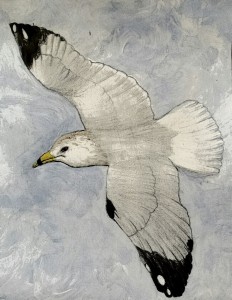

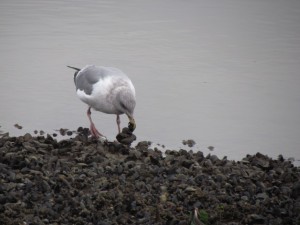
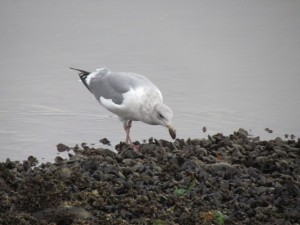
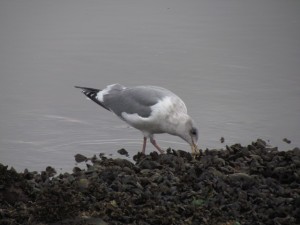

Leave a Reply